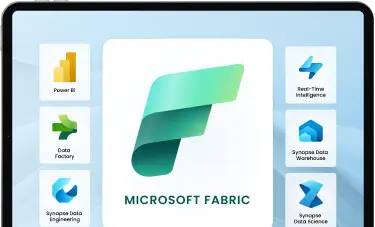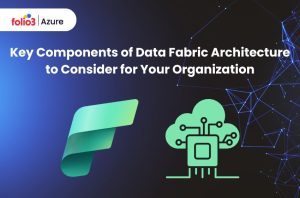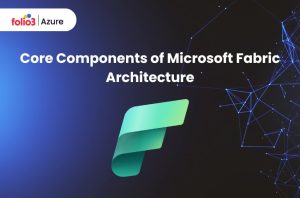It has become a potent necessity for businesses operating in today’s intense market to integrate advanced technologies with their enterprise systems to remain competitive and successful. One such emerging technology is Microsoft Fabric, which is a multi-purpose platform developed to augment the already powerful functionalities of ERP systems.
Merging Microsoft Fabric with ERP systems empowers businesses to simplify their operations, refine data management, and obtain valuable insights that lead to accurate decision-making.
This article explores how using Microsoft Fabric with ERP systems can refine your business processes, highlighting the benefits, challenges, and technical aspects.
Accelerate smart decisions with Microsoft Fabric's unified data and AI analytics.

Common Challenges in ERP Implementation
ERP system implementation is a difficult process with unique challenges. If these issues are not promptly resolved, they may have an adverse effect on the efficiency and effectiveness of your company’s operations.
Here are some common challenges businesses face during ERP system implementation:
- Data Silos: One of the primary challenges in ERP implementation is the presence of data silos. Data that resides in disparate systems results in fragmented information, making it difficult for departments to share data and collaborate efficiently.
- Integration Challenges: Integrating an ERP system with the existing business applications might be difficult. Compatibility problems, difficulties with data transfer, and the requirement for custom connectors can make the whole process quite challenging, which can result in delays and increased costs.
- Real-Time Data Access: Many businesses hustle with real-time data access after ERP system implementation. Without access to real-time data, decision-making can be difficult and slow, and the business may miss out on precious opportunities.
- User Adoption: Since ERP systems can be complex, it may be difficult to persuade and motivate all staff members to embrace the new system. Reluctance to change and a lack of training can also hamper user adoption, reducing the system’s overall productivity.
- Cost Overruns: The cost of ERP system implementation can easily exceed initial estimates due to unpredictable challenges, such as additional customization needs, extended timelines, and higher-than-anticipated consulting fees.
- Data Quality Issues: Poor data quality can have an immense impact on an ERP system’s performance. Inaccurate or incomplete data can lead to errors in reporting, forecasting, and decision-making, deteriorating the system’s effectiveness and productivity.
- Scalability: As businesses grow, their ERP systems must scale along with them. However, many businesses find that their ERP systems strive to keep up with soaring demands, leading to performance issues and system tie-ups.
Integration Benefits of Microsoft Fabric with ERP Systems
Integrating and using Microsoft Fabric with ERP systems leads to a myriad of benefits that overcome many of the challenges discussed above. This powerful integration boosts the functionality of your ERP system, providing contemporary tools and features to simplify and organize business processes and increase overall efficiency.
Here are some significant advantages:
1. Improved Data Synchronization
Integrating Microsoft Fabric with ERP systems assures consistent and up-to-date data across all platforms. This prevents data silos and facilitates a smooth data flow between departments, enhancing coordination, collaboration, and decision-making.
2. Enhanced Business Intelligence
Microsoft Fabric enhances the business intelligence capabilities of your ERP system, enabling advanced analytics, reporting, and real-time insights. This integration enables businesses to make data-driven decisions and stay competitive and at par with the latest market trends.
3. Automated Workflows
Integrating and using Microsoft Fabric with ERP systems enables businesses to automate their repetitive and routine tasks and processes. Therefore, minimizing manual labor and increasing operational efficiency. Automated workflows also eliminate the risk of human error and ensure consistency in business processes.
4. Scalability and Flexibility
Microsoft Fabric’s high level of scalability enables businesses to modify quickly to their evolving needs easily. Whether you are expanding operations or introducing new products, the integration ensures that your ERP system can manage increased workloads and changing requirements.
5. Unified Data Management
By integrating and using Microsoft Fabric with your ERP system, you can gather and centralize your data on a unified platform. This eradicates data silos and ensures that every department in your organization has access to consistent and accurate information.
Unified data management also simplifies compliance and reporting, as all data is stored and managed in a central hub.
6. Real-Time Data Insights
Microsoft Fabric facilitates real-time data processing and analytics, thus, providing your business with the most updated information. This feature empowers you for faster decision-making and prompt responses to shifting market conditions.
Whether you’re monitoring sales performance or managing supply chain operations, real-time insights are mandatory for staying ahead of the competition.
7. Seamless Integration with Other Microsoft Tools
Microsoft Fabric integrates easily with other Microsoft tools such as Power BI, Azure, and Dynamics 365. This smooth compatibility empowers you to benefit from the entire suite of Microsoft products to uplift your ERP system’s functionality.
For example, you can use Power BI to create dynamic dashboards that visualize your ERP data in real-time.
8. Enhanced Security and Compliance
Integrating and using Microsoft Fabric with your ERP system assists you in strengthening security by employing Microsoft’s solid security framework. This consists of features such as data encryption, multi-factor authentication, and compliance with global standards such as GDPR and HIPAA.
These security measures protect sensitive business data and ensure that your organization meets regulatory requirements.
9. Optimized Performance and Scalability
Microsoft Fabric is developed with the target of scaling your business, enabling you to add resources and expand your infrastructure as needed. This high scalability puts your mind at ease and ensures that your ERP system can handle massive workloads without jeopardizing performance.
Whether you’re expanding to new markets or increasing your product lines, Microsoft Fabric provides high flexibility to grow your business.
10. Customizable Workflows
Integration and using Microsoft Fabric with ERP systems lets you customize workflows, automate routine tasks, and personalize processes to meet your unique business needs. This customization not only boosts efficiency but also supports greater adaptability as your business changes and grows.
11. Cost Efficiency
By integrating Microsoft Fabric with your ERP system, you can minimize operational costs that emerge with maintaining multiple platforms. The integration simplifies your IT infrastructure, reducing the need for additional hardware, software, and maintenance.
This cost efficiency empowers you to allocate resources to high-priority areas of your business.
12. Improved Collaboration
Microsoft Fabric’s integration capabilities enable teams across various departments to collaborate more efficiently. Shared data, synchronized workflows, and unified communication tools develop a collaborative environment, leading to better coordination and more connected business strategies.
13. Advanced Predictive Analytics
By improving the predictive analytics capabilities of your ERP system, Microsoft Fabric helps you forecast trends, predict customer demands, and make data-driven choices. This capability makes keeping ahead of the competition possible, which is especially beneficial in areas where market conditions change rapidly.
14. Simplified Integration with Third-Party Applications
Microsoft Fabric’s open architecture makes it a breeze to integrate with third-party applications, amplifying the functionality of your ERP system. This flexibility enables you to select the best tools for your business, whether it’s for CRM, marketing automation, or e-commerce.
Accelerate smart decisions with Microsoft Fabric's unified data and AI analytics.

Technical Approach to Integration
Successfully integrating and using Microsoft Fabric with ERP systems requires meticulous planning and execution. Here’s a technical outline of the integration process, best practices, and possible challenges:
1. Integration Architecture
The integration architecture usually consists of data connectors that smoothen the flow of information between Microsoft Fabric and the ERP system. These connectors facilitate a smooth data exchange, enabling both systems to function as a unified platform.
Moreover, Microsoft Fabric’s open APIs enable custom integrations personalized according to your business requirements.
2. Data Flow and Connectors
To guarantee a smooth integration, mapping out the data flow between Microsoft Fabric and your ERP is the essential system. This involves identifying important data points, such as financial transactions, inventory levels, and customer data, and determining how they will be synchronized across platforms.
Using connectors like Azure Data Factory can simplify this process by automating data transfer and transformation.
Best Practices for Integration
- Data Mapping: Carefully map data fields between Microsoft Fabric and your ERP system to warrant consistency and accuracy. This step is critical for avoiding data discrepancies and ensuring that all departments have access to the same and accurate information.
- Data Quality Assurance: Enforce data quality checks to ensure that only accurate and relevant data is integrated. This helps prevent errors in reporting and decision-making.
- Security Considerations: Assure that your integration process conforms to security best practices, including data encryption, access controls, and compliance with industry standards. This safeguards sensitive business data and reduces the risk of data breaches.
- Testing and Validation: Before fully deploying the integration, execute thorough testing to detect and resolve any issues. This step ensures that the integration works as intended and meets your business needs.
Challenges and Solutions
- Integration Complexity: Integrating Microsoft Fabric with complex ERP systems can be a daunting task owing to the need for custom connectors and comprehensive data mapping. To handle this, consider working with experienced integration partners who can guide you through the process.
- Data Migration Issues: Migrating data from old systems to the new integrated platform might result in data loss or corruption if not handled carefully. Employ solid data migration tools and techniques to minimize these risks.
- User Resistance: Employees may show reluctance to adopt the new integrated system owing to its complexity. To overcome this, in-depth training and support should be provided to help users become acquainted and comfortable with the new processes.
Azure.Folio3 is here to Help
If you’re interested in gaining an extensive and profound understanding of Microsoft Fabric’s capabilities, need assistance with implementation, or want to comprehend how Microsoft Fabric can centralize your data effectively, our excellent team of experts at Azure.Folio3 is here to help.
With immense experience in ERP integrations, ERP system implementation, and a deep understanding of Microsoft Fabric, we can guide you through every step of the process, from early planning to full deployment.
Whether you’re seeking ERP System optimization of your current ERP system or exploring new opportunities that come with Microsoft Fabric, we’re ready to support your business needs.
To explore more, visit our Microsoft Fabric service page and uncover how we can help you leverage the full potential of Microsoft Fabric for your business.
Conclusion
Integrating and using Microsoft Fabric with ERP systems provides a strong solution for businesses seeking to simplify and organize their operations, refine data management, and improve decision-making.
By handling common ERP challenges, this potent integration provides advanced tools for data synchronization, business intelligence, and automation this is all achieved while ensuring scalability and flexibility for future growth.
However, successful integration needs meticulous and thorough planning, implementation of best practices, and motivation to overcome technical challenges.
If you’re ready to uplift your ERP system to the highest level with Microsoft Fabric, now is the best time to do it. Whether you need help with the technical challenges of integration or want to explore how Fabric can benefit your business, Azure.Folio3 is here to fully assist you through the process.
Contact us today to start your journey toward a more systematic and data-driven future for your business.


